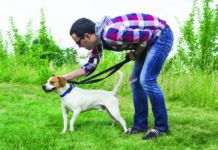You adopt a golden retriever because you know that breed gets along well with people, but as she grows into adulthood you find that she’s just not that much of a social animal. Some would even say she’s a bit aloof. What happened?
Nothing. It’s just that, according to a new study involving more than 18,000 dogs, there’s only a 40 percent chance that a golden retriever will score high for human sociability. When you consider that the same study found a mixed-breed dog has a 22 percent chance of scoring high for getting along well with people, the odds for a golden’s rapport with people become even more underwhelming.
Overall, breed actually explains only 9 percent of a dog’s behavior, on average, according to the results of the study, conducted by researchers at MIT’s Broad Institute and the University of Massachusetts Medical School. They made the findings when they sequenced more than 2,000 of the dogs’ genomes and asked the human family members of the 18,000-plus dogs hundreds of questions about their pets’ personalities and the things they liked to do.
Why is breed so much less predictive of behavior than people assume? It used to be that dogs were bred simply to do certain kinds of jobs: hunt, herd, or guard. That went on for thousands of years. But today’s roughly 200 dog breeds are all less than 160 years old, “a blink in evolutionary history,” the researchers write. And dogs are not bred primarily for how they act but for how they look. Conformation to a physical ideal when it comes to dogs is “a Victorian invention,” the investigators say, meaning it’s a pretty new concept in human history.
It makes sense that getting dogs of a certain breed to look the same is easier than getting them to act the same or have similar temperaments. Genes for looks are pretty simple, relatively speaking. But each behavioral trait is polygenic, meaning it involves many genes, not just one set of genes arranged in one particular way, and those genetic influences on behavior have not been sorted out by breeders.
Additionally, behavioral characteristics are influenced by a dog’s environment. A dog is going to have brown eyes or a certain texture of fur no matter how she is brought up and what she is exposed to. But how she interacts with other people and with other dogs, how trainable she is, how affectionate, are all going to be influenced by her life experiences. In fact, the researchers point out, prior studies have found that behavioral variations between dogs within a particular breed are similar to the variations in dogs between breeds.
Time of life influences canine behavior, too. Puppies of any breed are far more toy-oriented than one of the most toy-oriented breeds of all: German shepherds.
Some behavior traits are more breed-aligned
With certain behaviors, breed is more predictive than others, the researchers found. For instance, biddability — meaning agreeability and being willing to do what you ask — has an okay chance for marking a breed (think golden retriever or Border collie). Whether or not a dog’s motor patterns cause her to like toys is also relatively predictable. But “relatively” is the operative word. Breed type predicts these behaviors, but only up to a point.
When it comes to things like how easily a dog is provoked by frightening or uncomfortable stimuli, breed is “almost uninformative,” the scientists say. The bottom line, the researchers write, is that “breed alone is not, contrary to popular belief, enough to predict an individual [dog’s] disposition.”
So how do you choose a pet who is right for you?
If breed can’t give you enough information about what kind of behavior a dog will engage in and what kind of temperament she will have, how can you figure out which dog to adopt?
The rules for adopting a purebred dog should be the same as for adopting mixed breed dogs, which make up roughly half the pet dogs in this country. Spend some time with the animal. See if she likes what you like — to play with a ball, or sit and cuddle, or fetch a toy. You can also drop something that lands with a clang and see how the dog reacts — whether she gets alarmed or barely pays attention.
Also, see how she reacts when the breeder or shelter employee walks away. Does she seem to like being with you, or does she get nervous? Is she willing to let you stroke her on the belly or touch her toes? You can get a lot of information about a dog’s temperament that way. And the older the dog, the better the sense you’ll get of who she really is. Her behavior will already have been largely shaped by
her experiences.





